North–South Expressway (Malaysia)
| |
|---|---|
|
[[File: 
Alor Star North–South Expressway (Malaysia) (Peninsular Malaysia) |290px|alt=]] Route of the North-South Expressway | |
| Route information | |
|
Part of | |
| Maintained by PLUS Malaysia Berhad with its subsidiary Projek Lebuhraya Usahasama Berhad | |
| Length: |
772 km (480 mi) |
| Existed: | 1982 – present |
| History: | Completed in 1994 |
| Major junctions | |
| North end: | Bukit Kayu Hitam, Kedah |
|
(Penang Second Bridge) | |
| South end: | Johor Bahru, Johor |
| Location | |
| Major cities: | Jitra, Alor Star, Sungai Petani, Butterworth, Taiping, Kuala Kangsar, Ipoh, Gopeng, Tapah, Tanjung Malim, Rawang, Kuala Lumpur, USJ, Putra Heights, Putrajaya, Sepang, Nilai, Seremban, Alor Gajah, Melaka, Yong Peng, Ayer Hitam, Skudai, Johor Bahru |
| Highway system | |
The North–South Expressway (NSE) (Malay: Lebuhraya Utara-Selatan; Jawi: ليبوهراي اوتارا-سلتن; Chinese: 南北大道) is the longest expressway in Malaysia with the total length of about 772 km (480 mi) running from Bukit Kayu Hitam in Kedah near the Malaysian-Thai border (connects with Phetkasem Road (Route 4) in Thailand) to Johor Bahru at the southern portion of Peninsular Malaysia and to Singapore. The expressway links many major cities and towns in western Peninsular Malaysia, acting as the 'backbone' of the west coast of the peninsula. It is also known as PLUS Expressway, named after the highway's concessionaire, Projek Lebuhraya Utara Selatan Berhad (North South Expressway Project; abbreviated as PLUS). But today the company changed its name into Projek Lebuhraya Usahasama Berhad (PLUS) which is a company subsidiary of PLUS Malaysia Berhad (PMB).
This expressway passes through 7 states on the peninsula: Johor, Malacca, Negeri Sembilan, Selangor, Perak, Penang and Kedah. It provides a faster alternative to the old Federal Route ![]() , thus reducing travelling time between various towns & cities. The expressway is part of the Asian Highway Network of route
, thus reducing travelling time between various towns & cities. The expressway is part of the Asian Highway Network of route ![]() .
.
Overview
It is divided into a few main routes; ![]() (northern route from Bukit Kayu Hitam to Kuala Lumpur) which also incorporates the
(northern route from Bukit Kayu Hitam to Kuala Lumpur) which also incorporates the ![]() Penang Bridge,
Penang Bridge, ![]() (southern route from Kuala Lumpur to Johor Bahru). The New Klang Valley Expressway (NKVE), part of the
(southern route from Kuala Lumpur to Johor Bahru). The New Klang Valley Expressway (NKVE), part of the ![]() route, starts from Bukit Raja, Klang to Jalan Duta exit in Kuala Lumpur. The North–South Expressway Central Link (ELITE)
route, starts from Bukit Raja, Klang to Jalan Duta exit in Kuala Lumpur. The North–South Expressway Central Link (ELITE) ![]() , opened in 1997, is a highway built to bypass Kuala Lumpur. It starts from the Shah Alam interchange on the NKVE
, opened in 1997, is a highway built to bypass Kuala Lumpur. It starts from the Shah Alam interchange on the NKVE ![]() , past Subang Jaya, Putrajaya and Kuala Lumpur International Airport, and ends at the Nilai Utara interchange on the
, past Subang Jaya, Putrajaya and Kuala Lumpur International Airport, and ends at the Nilai Utara interchange on the ![]() . The
. The ![]() is the Second Link Expressway (Linkedua), which is connected to Malaysia-Singapore Second Link, starting at Senai Airport and ends in Tanjung Kupang before crossing. PLUS also obtained the Seremban-Port Dickson Highway,
is the Second Link Expressway (Linkedua), which is connected to Malaysia-Singapore Second Link, starting at Senai Airport and ends in Tanjung Kupang before crossing. PLUS also obtained the Seremban-Port Dickson Highway, ![]() , which starts at Mambau in Seremban with an interchange at Lukut and ending near the town centre in Port Dickson and Butterworth–Kulim Expressway,
, which starts at Mambau in Seremban with an interchange at Lukut and ending near the town centre in Port Dickson and Butterworth–Kulim Expressway, ![]() which starts from Butterworth, Penang to Kulim in Kedah.
which starts from Butterworth, Penang to Kulim in Kedah.
![]() and
and ![]() end in Kuala Lumpur. The
end in Kuala Lumpur. The ![]() from the North becomes the New Klang Valley Expressway which further links into the NSE Central Link or for people travelling to Kuala Lumpur exit at the Jalan Duta Toll Plaza which links to the Sprint Expressway
from the North becomes the New Klang Valley Expressway which further links into the NSE Central Link or for people travelling to Kuala Lumpur exit at the Jalan Duta Toll Plaza which links to the Sprint Expressway ![]() and the Kuala Lumpur Middle Ring Road 1 (MRR1)
and the Kuala Lumpur Middle Ring Road 1 (MRR1) ![]() . The
. The ![]() from the South ends in Sungai Besi which then changes into the
from the South ends in Sungai Besi which then changes into the ![]() Kuala Lumpur-Seremban Expressway with interchanges to the Federal Highway Route
Kuala Lumpur-Seremban Expressway with interchanges to the Federal Highway Route ![]() via Salak Expressway
via Salak Expressway ![]() , Sungai Besi Expressway
, Sungai Besi Expressway ![]() and heads towards the city centre.
and heads towards the city centre.
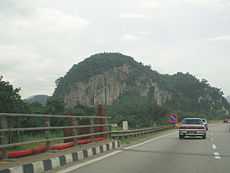 |
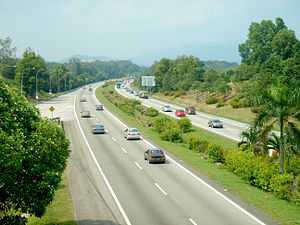 South section of North–south Expressway, facing towards Kuala Lumpur, near Ayer Keroh, Malacca |
Signs in the expressway |
History
The planning of the national expressway started in the mid-1970s. In 1977, the Malaysian Ministry of Works received official instructions to draw plans of an expressway from the Malaysia-Thailand border (Bukit Kayu Hitam) to the Johor Causeway. In 1980, the Malaysian Highway Authority (LLM) was established to monitor all the work progress of the first national expressway.
At that time, all construction works of the expressway between 1982 to 1988 was solely administered by Malaysian Highway Authority before being transferred to Projek Lebuhraya Utara-Selatan Berhad (PLUS) on 13 May 1988. As the construction works continued, segments of the highway were opened to traffic as they were finished to help fund the construction works. PLUS continued all the construction works from 1988 until completion in 1994, 15 months earlier than scheduled. The expressway was officially opened on September 8, 1994 by Malaysian prime minister at that time, Tun Dr. Mahathir bin Mohamad.
Pioneer routes
The pioneer route for ![]() North–South Expressway Northern Route was the Bukit Kayu Hitam – Jitra section (both in Kedah), which was initially a part of the Federal Route
North–South Expressway Northern Route was the Bukit Kayu Hitam – Jitra section (both in Kedah), which was initially a part of the Federal Route ![]() , opened in 1 April 1985.
, opened in 1 April 1985.
The pioneer route for ![]() North–South Expressway Southern Route was a toll section of the Kuala Lumpur-Seremban Expressway (Sungai Besi - Labu), opened on 16 June 1982. However, the section from Razak Mansion to Sungai Besi toll plaza was not acquired by PLUS Malaysia Berhad but rather by ANIH Berhad (Formerly known as MetaCorp Sdn Bhd) – as a result, the section was not included in the southern route.
North–South Expressway Southern Route was a toll section of the Kuala Lumpur-Seremban Expressway (Sungai Besi - Labu), opened on 16 June 1982. However, the section from Razak Mansion to Sungai Besi toll plaza was not acquired by PLUS Malaysia Berhad but rather by ANIH Berhad (Formerly known as MetaCorp Sdn Bhd) – as a result, the section was not included in the southern route.
Monuments
The North-South Expressway Monument was erected at Rawang Rest and Service Area (R&R) (North bound) near Rawang, Selangor on 8 September 1994. At this monument there is a capsule that contains documents that have been cultivated by the Fourth Prime Minister of Malaysia, Tun Dr Mahathir Mohammad in conjunction with the official opening of the North-South Expressway on September 8, 1994 and the capsule will be released after the expiry of the Concession of the North-South Expressway by PLUS Expressways on May 31, 2018.
Malay
"Tugu ini melambangkan mercu kejayaan Pembinaan Lebuhraya Utara-Selatan yang menghubungkan Bukit Kayu Hitam di sempadan Thailand di Utara dengan Johor Bahru di tambak bersempadan dengan Singapura di Selatan. Pembinaan Lebuhraya sepanjang 848km ini, yang merentasi paya gambut dan hutan yang belum pernah diterokai serta bukit-bukit granit, merupakan suatu pencapaian yang menakjubkan. Juga mengkagumkan ialah cara pragmatik di mana gabungan usaha di antara pihak awam dan swasta yang telah berjaya menghasilkan pencapaian ini. Lebuhraya ini adalah hasil usaha bersama Lembaga Lebuhraya Malaysia, sebuah badan berkanun, yang telah membuat perancangan awal dan memulakan pembinaan, dengan Projek Lebuhraya Utara-Selatan Berhad, sebuah syarikat swasta yang telah dianugerahkan Konsisi untuk membiayai, merekabentuk, membina, mengendali dan menyelenggarakan Lebuhraya ini. Hasil usaha ini mempamerkan kejayaan satu wawasan menjadi sebuah kenyataan setelah merintangi pelbagai cabaran yang mengancam untuk menghalangnya. Ia memberi pengesahan terhadap kejayaan dasar penswastaan Kerajaan dan melambangkan suatu usaha kebangsaan yang dibiayai dan dikendalikan dengan jayanya oleh rakyat Malaysia. Tugu ini juga memperingati usaha gigih pemimpin-pemimpin Kerajaan, perkhidmatan awam, ahli perniagaan, institusi kewangan, perunding, jurutera dan pakar-pakar bidang, serta kontraktor dan tenaga buruh, yang telah memainkan peranan penting masing-masing dalam menghadapi cabaran-cabaran dan membawa projek ini kepada tahap kejayaannya. Mereka yang menggunakan Lebuhraya ini diharap bukan sahaja akan menikmati sumbangan usaha pelbagai pihak dalam pembinaannya bahkan dapat menghargai sumbangan Lebuhraya ini terhadap pembangunan negara."
English
"This monument symbolizes the pinnacle of successful for the construction of the North-South Expressway that connects Bukit Kayu Hitam bordering with Thailand in the North to Johor Bahru in the Causeway bordering with Singapore in the South. The construction of the 848km expressway, across the peat swamps and forests and hill untapped granite hills, is an amazing achievement. Also impressive is the pragmatic way in which the combined efforts between the public and private sectors has resulted in this achievement. The expressways is the result of joint efforts of the Malaysian Highway Authority, a statutory body, which has been planned early and begin construction, with the Projek Lebuhraya Utara-Selatan Berhad (PLUS) (North-South Expressway Project), a private company that was awarded concessions to finance, design, construct, operate and maintain the expressways. Such efforts shows an improvement visions into a reality after across a variety of challenges that threaten to stop. It acknowledged the success of the Government and represents a national effort funded and operated successfully by Malaysians. This monument also commemorates the efforts of leaders of the Government, public services, businesses, financial institutions, consultants, engineers and consultants, as well as contractors and labours, which has played an important role in facing their challenges and bring this project to a level of success. Those who use this expressway will be expected not only to enjoy the various parties in the construction efforts, but also can even appreciate this expressway contribution towards national development."
Current developments
Six-lane widening works
Plans to upgrade the stretches from Slim River to Tanjung Malim, Tanjung Malim to Rawang (Northern route), Seremban to Senawang, and Senawang to Ayer Keroh (Southern route) was approved by the government for better traffic flow. It was completed in 2007.
Kuala Lumpur-Penang Through Traffic (Ipoh North (Jelapang) – Ipoh South)
The Jelapang and Ipoh South toll plazas were demolished in 2009 to make a non-stop route across Ipoh. This is achieved through the construction of two local-express lanes for each side, which are only accessible via EXIT 138 Ipoh South Exit (for northbound traffic) and EXIT 141 Ipoh North Exit (for southbound traffic). The toll plazas in Ipoh are therefore relocated at each ends of the local-express lanes.
The decision to demolish both toll plazas was made as a result of accidents which happened at Jelapang toll plaza. Since the toll plaza was opened in 28 September 1987, there were many accident cases which involved brake failure in heavy vehicles due to hard braking when proceeding downhill to the toll plaza. On 7 June 2008, the new Ipoh North toll plaza (South bound) replacing old Jelapang toll plaza opened to traffic, followed by north bound on 15 August 2008. Beginning 11:00 am on 14 July 2009, the Kuala Lumpur-Penang through traffic is now opened to traffic. With the opening of the 14.7-kilometre (9.1 mi) between Ipoh North (Jelapang) and Ipoh South stretch, highway users are no longer required to stop for toll transactions at the Ipoh North and Ipoh South Toll Plazas.
Fourth Lane additions
On July 2010, the operator PLUS Expressways Berhad announced that the government has awarded contracts to build a fourth lane on certain stretches of the highway, namely from Shah Alam to Jalan Duta, from Shah Alam to Rawang and from Nilai (North) to Port Dickson. On October 2012, the upgrading works for this project began.
Carriageways
Generally the expressway consists of 4 lanes, 2 for each direction.
There are some exceptions to this; the following are stretches with 6 lanes or 8 lanes (3 or 4 each way):
Six lane carriageways
| Highways | Stretches |
|---|---|
| North–South Expressway Southern Route | Sungai Besi to Ayer Keroh (except Nilai North to Port Dickson stretches) |
| New Klang Valley Expressway | Bukit Raja to Shah Alam |
| North–South Expressway Northern Route | Rawang to Slim River |
| North–South Expressway Northern Route | Sungai Dua to Juru located at Penang |
| North–South Expressway Central Link | Shah Alam to Nilai North |
| Second Link Expressway | Pulai to Ayer Rajah Expressway (Tuas, Singapore) |
| Penang Bridge | Prai to Gelugor |
Eight lane carriageways
| Highways | Stretches |
|---|---|
| North–South Expressway Southern Route | Nilai North to Port Dickson |
| New Klang Valley Expressway | Shah Alam to Jalan Duta |
| North–South Expressway Northern Route | Bukit Lanjan to Rawang |
Speed limit
North–South Expressway is designed as a high-speed long distance expressway therefore the default speed limit on the expressway is 110 km/h (68 mph), but there are some exceptions in some places for several reasons, including:-
- 1 km before every toll plaza: 60 km/h (to help the traffic to slow down)
- Bukit Kayu Hitam-Jitra stretch : 90 km/h (expressway section with at-grade junctions) (Kedah)
- Sungai Dua-Juru : 90 km/h (due to heavy traffic at Penang Bridge) (Penang)
- Kuala Kangsar-Jelapang stretch : 80 km/h (highland stretch with dangerous corners) (Perak)
- Jelapang – Ipoh South stretch : 90 km/h for main carriageways; 70 km/h for toll-free local-express lanes (to control the traffic flow of the non-stop main carriageways and the toll-free local-express lanes) (Perak)
- Gua Tempurung stretch : 90 km/h (highland stretch) (Perak)
- Bukit Lanjan Interchange : 80 km/h (to control traffic flow of NKVE and the main link of northern route to avoid accidents) (Selangor)
- Bukit Lanjan-Jalan Duta stretch : 90 km/h (steep uphill/downhill stretch) (Kuala Lumpur)
- Sungai Besi-Bangi : 90 km/h (due to high traffic capacity) (Kuala Lumpur- Selangor)
Notable incidents
- On March 9, 2007, 6 passengers were killed in a bus crash near Menora Tunnel, Perak.
- On August 13, 2007, 20 people were killed in a bus crash near Changkat Jering, Perak.
- On March 27, 2008, a Singaporean family of 4 were killed in an accident near Tangkak, Johor, leaving behind a 2-month-old baby.
- On December 2, 2008 at about 0315 hrs, a Singaporean biker, who was returning from a trip from Hat Yai, Thailand was killed after crashing his bike into an overturned lorry near Simpang Empat, Melaka.
- On December 7, 2008, 10 passengers were killed in a bus crash at km 146.8 between Tangkak and Pagoh, Johor.
- On 13 April 2009, six people were killed in double decker express bus crash at km 443 near Rawang, Selangor.
- On 26 December 2009, ten passengers were killed and two injured after a northbound double-decker express bus skidded and hit the road divider at Km 272.8 about 8 km from the Ipoh South toll plaza near Ipoh, Perak.
- On 10 October 2010, twelve people were killed and more than 50 others injured in an highway crash involving two buses, three cars and a van at Km 223, near the Simpang Ampat interchange, Melaka.
- On 17 April 2014, lawyer and politician Karpal Singh was killed in a collision between a lorry and the vehicle in which he was travelling from Kuala Lumpur to Penang at Km 306, near Gua Tempurung at Kampar, Perak.
Measures taken to reduce accidents

Most heavy vehicles are only allowed to travel 80–90 km/h by law. Considering that two lanes are inadequate for smooth traffic flow, the expressway is being widened as a result of the increasing number of fatal accidents along this highway.
It has been recently decided that the two-lane 110 km/h highway will be upgraded to a three-lane 110 km/h highway to prevent accidents, however another lane was being added on the selected stretches to increase it to four-lane.
Toll system
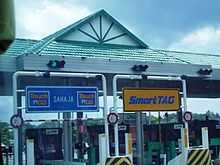
The North–South Expressway is a toll expressway with two toll systems:-
- Open system – Users only have to pay at certain toll plazas within the open system range for a fixed amount. "Open system" is used in the following stretches of the North–South expressway:
- Batu Tiga and Sungai Rasau, (Selangor)
- Bukit Kayu Hitam, (Kedah)
- Jitra, (Kedah)
- Penang Bridge,
- Kempas, (Johor)
- Johor-Singapore Causeway,
- Lukut and Mambau, (Negri Sembilan)
- Tanjung Kupang, Taman Perling and Lima Kedai (Johor).
- Closed system – Users collect toll tickets or PLUSTransit cards before entering the expressway at respective toll plazas and pay an amount of toll at the exit toll plaza plus the distance from the plaza to the Limit of Maintenance Responsibility (LMR). Beginning 18 June 2013, the PLUSTransit reusable transit cards will be implemented at all PLUS expressways network to replace the transit ticket.
PLUS Travel Incentive Program
Effective 1 January 2009, Class 1 highway users traveling on the expressway (NSE) and North–South Expressway Central Link (ELITE) between 12:00 midnight and 7:00 am will be able to enjoy 10 percent toll discount. This is part of the PLUS’ initiatives to offer added value to its customers on both highways.
There are three toll incentive packages of the PLUS Travel Incentive Program which will be enjoyed by the customers on the PLUS and ELITE highways which are:-
Incentive One
- Users of Class 1 vehicles using the highway between 12:00 midnight and 7:00 am will enjoy 10 percent toll discount.
- Duration : 1 January 2009 until 31 December 2010.
Incentive Two
- Additional 10 percent toll discount will be given to highway users (Class 1 vehicles only) traveling between 12.00 midnight to 7.00 am on selected six days during Hari Raya Aidilfitri, Chinese New Year, Deepavali and Christmas festive seasons.
- Duration : 1 January 2009 until 31 December 2010.
Incentive Three
- Electronic Toll Payment users spending monthly cummulative minimum amount of RM200 will enjoy 5 percent rebate (for usage on PLUS and ELITE highways only)
- This offer is given to users who are registered with the PLUS Loyalty Program which will be launched later.
- Duration : Beginning 1 January 2009
Toll rates
Toll rate classes for every PLUS Expressways Networks (except Penang Bridge)
| Class | Type of vehicles | Payment | Notes |
|---|---|---|---|
| 0 | Motorcycles (Vehicles with two axles and two wheels) | Free | Except: Tanjung Kupang Toll Plaza (Malaysia-Singapore Second Link) TnG |
| 1 | Private Cars (Vehicles with two axles and three or four wheels (excluding taxi and bus)) | RM (Cash) TnG TAG | |
| 2 | Vans and other small good vehicles (Vehicles with two axles and six wheels (excluding bus)) | RM (Cash) TnG TAG | |
| 3 | Large Trucks (Vehicles with three or more axles (excluding bus)) | RM (Cash) | Cash only Except: TnG for: Sultan Iskandar Building (Johor-Singapore Causeway) Kempas Toll Plaza (North-South Expressway Southern Route) Lima Kedai, Tanjung Kupang and Perling toll plazas (Second Link Expressway) Batu Tiga and Sungai Rasau toll plazas (Federal Highway Route 2) |
| 4 | Taxis | RM (Cash) | Cash only, paid by passengers only. Except: TnG for: Sultan Iskandar Building (Johor-Singapore Causeway) Kempas Toll Plaza (North-South Expressway Southern Route) Lima Kedai, Tanjung Kupang and Perling toll plazas (Second Link Expressway) Batu Tiga and Sungai Rasau toll plazas (Federal Highway Route 2) |
| 5 | Buses | RM (Cash) | Cash only Except: TnG for: Sultan Iskandar Building (Johor-Singapore Causeway) Kempas Toll Plaza (North-South Expressway Southern Route) Lima Kedai, Tanjung Kupang and Perling toll plazas (Second Link Expressway) Batu Tiga and Sungai Rasau toll plazas (Federal Highway Route 2) |
Toll rate classes for Penang Bridge
| Class | Type of vehicles | Payment | Notes |
|---|---|---|---|
| 1 | Motorcycles, bicycles or vehicles with 2 or less wheels | RM (Cash) TnG | |
| 2 | Motorcycle with sidecars, cars including station wagon and commercial vehicles on three wheels | RM (Cash) TnG TAG | For taxis, toll charges are paid by passengers only. |
| 3 | Lorries, vans and buses with two axles and four wheels | RM (Cash) TnG TAG | |
| 4 | Lorries, vans and buses with two axles and five and six wheels | RM (Cash) | Cash only |
| 5 | Vehicles with three axles | RM (Cash) | Cash only |
| 6 | Vehicles with four axles | RM (Cash) | Cash only |
| 7 | Vehicles with five or more axles | RM (Cash) | Cash only |
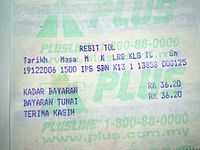
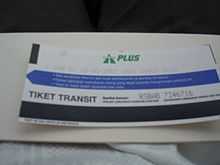
Toll Abbreviation
| Abbreviation | Exits | Name of interchanges |
|---|---|---|
| AHT | 244 | Ayer Hitam |
| AKH | 231 | Ayer Keroh |
| ALP | 152 | Alor Pongsu |
| ASS | 177 | Alor Setar South |
| ASU | 178 | Alor Setar North |
| BBR | 153 | Bandar Baharu |
| BDR | 130 | Bidor |
| BGR | 237 | Bukit Gambir |
| BGS | 211 | Bangi |
| BKB | 118 | Bukit Beruntung |
| BKH | 185 | Bukit Kayu Hitam |
| BKM | 150 | Bukit Merah |
| BKR | 101 | Bukit Raja |
| BRG | 124 | Behrang |
| BRT | 166 | Bertam |
| BSP | 606 | Bandar Saujana Putra |
| BTS | 158 | Bukit Tambun (South) |
| BTU | 158 | Bukit Tambun (North) |
| BTT | Batu Tiga | |
| BTR | 119 | Bukit Tagar |
| CKJ | 146 | Changkat Jering |
| DMR | 106 | Damansara |
| EBN | 602 | Ebor North |
| EBS | 602 | Ebor South |
| GPG | 135 | Gopeng |
| GRN | 173 | Gurun |
| HKG | Hutan Kampung | |
| HSB | 114 | Hospital Sungei Buloh |
| IPU | 141 | Ipoh North |
| IPS | 139 | Ipoh South |
| JLD | 111 | Jalan Duta |
| JRU | 160 | Juru |
| JSN | 233 | Jasin |
| JTR | 182 | Jitra |
| JWI | 156 | Jawi |
| KDR | 107 | Kota Damansara |
| KJG | 210 | Kajang |
| KKS | 143 | Kuala Kangsar |
| KLA | 608 | KLIA |
| KLI | 252 | Kulaijaya |
| KPS | 255 | Kempas |
| LBB | 120 | Lembah Beringin |
| LKT | 2903 | Lukut |
| MAC | 245 | Machap |
| MBU | 2901 | Mambau |
| NLI | 215 | Nilai |
| PBSB | 161 | Penang Bridge |
| PDG | 175 | Pendang |
| PDN | 219A | Port Dickson North |
| PDS | 219B | Port Dickson South |
| PGH | 238 | Pagoh |
| PLI | 223 | Pedas/Linggi |
| PPM | 213 | Putra Mahkota |
| PSR | 126 | Slim River |
| PTH | 605 | Putra Heights |
| PTJ | 607 | Putrajaya |
| RAW | 116 | Rawang |
| RWS | 115 | Rawang South |
| SAT | 227 | Simpang Ampat (Alor Gajah) |
| SBG | 104 | Subang |
| SBI | Sungai Besi | |
| SBN | 218 | Seremban |
| SBY | 117 | Sungai Buaya |
| SDK | 250 | Sedenak |
| SEA | 603 | Seafield |
| SGB | 113 | Sungai Buloh |
| SGD | 165 | Sungai Dua |
| SGR | Sungai Rasau | |
| SHA | 103/601 | Shah Alam |
| SKD | 254 | Skudai |
| SKI | 128 | Sungkai |
| SVC | 212 | Southville City |
| SNU | 253 | Senai North |
| SPP | 137 | Simpang Pulai |
| SPR | 247 | Simpang Renggam |
| SPS | 168 | Sungai Petani South |
| SPU | 170 | Sungai Petani North |
| STA | 244 | Setia Alam |
| SWG | 220 | Senawang |
| TGK | 235 | Tangkak |
| TGM | 121 | Tanjung Malim |
| TPH | 132 | Tapah |
| TPU | 148 | Taiping North |
| TBN | 138 | Tambun |
| TLK | Lima Kedai | |
| TTK | Tanjung Kupang | |
| TTP | Perling | |
| UPM | 209 | UPM |
| USJ | 604 | USJ |
| YPS | 242 | Yong Peng South |
| YPU | 241 | Yong Peng North |
Facilities along the expressway
- Rest and service areas located about 60 km from each other
- Layby parking areas are located approximately every two junctions
- Emergency phones every 2 km
- PLUSLINE hotline number
- PLUS Ronda (PLUS patrol) service to assist drivers in the event of vehicle problems on the expressway
- PLUS helicopter patrol unit to monitor PLUS expressways
Records
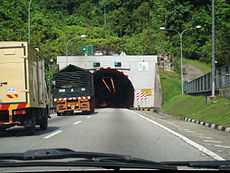
- North–South Expressway is Malaysia's first long-distance expressway as well as Malaysia's longest expressway.
- Menora Tunnel, an 800 m (2,600 ft) tunnel on the North–South Expressway Northern Route near Jelapang, was once Malaysia's longest highway tunnel at the time of its construction.
- The largest toll plaza in Malaysia is Bandar Cassia-PLUS Toll Plaza (Gateway Arch Toll Plaza) in Penang Second Bridge
 with over 28 lanes (excluding additional motorcycle toll plaza). The second largest toll plaza is Sungai Besi Toll Plaza in North-South Expressway Southern Route
with over 28 lanes (excluding additional motorcycle toll plaza). The second largest toll plaza is Sungai Besi Toll Plaza in North-South Expressway Southern Route  with over 18 lanes (excluding additional toll booths).
with over 18 lanes (excluding additional toll booths). - The longest bridge along the expressway is Sungai Perak Bridge (Jambatan Sultan Azlan Shah) with the length of 300 m (980 ft).
- The first Rest and Service Area on the North-South Expressway is the Ayer Keroh Rest and Service Area in the North–South Expressway Southern Route opened in 1987.
- North–South Expressway is the first expressway in Malaysia that provides overhead bridge restaurants.
- The longest flyover bridge along the NSE network is Batu Tiga flyover in the North–South Expressway Central Link.
- The most expensive section of the expressway is the Gopeng-Tapah section. At RM200 million, it translate to RM 20 million per kilometre. Embankment strengthening is the major contributor for this escalating cost.
- The longest stretch of the North-South Expressway network is the Pagoh-Yong Peng (North) section. This 47 kilometre stretch passing Mount Maokil and the plains of Seri Medan and Sungai Sarang Buaya.
- The PLUS Speedway (formerly ELITE Speedway) in USJ Rest and Service Area on North–South Expressway Central Link is the first highway go-kart circuit in Malaysia.
- North–South Expressway forms 80% of Malaysian part of the Asian Highway Network, specifically Asian Highway Network 2
 . The other expressways in Malaysia included in the route are Skudai Highway, Kuala Lumpur Middle Ring Road 1 and Johor Causeway.
. The other expressways in Malaysia included in the route are Skudai Highway, Kuala Lumpur Middle Ring Road 1 and Johor Causeway. - The Nilai Memorial Park near Nilai Layby on North–South Expressway Southern Route is the first closed tolled expressway public memorial park in Malaysia.
- The PLUS Art Gallery in Ayer Keroh Overhead Bridge Restaurant (OBR) is the first highway art gallery in Malaysia.
- Kempas Highway (Johor State Route J3
 ) is the only state route ever built by an expressway concessionaire company (PLUS Expressway Berhad).
) is the only state route ever built by an expressway concessionaire company (PLUS Expressway Berhad). - The Machap Rest and Service Area (north bound) at the North–South Expressway Southern Route
 is the first fully air-conditioned rest area in Malaysia, after it was renovated during mid-2008.
is the first fully air-conditioned rest area in Malaysia, after it was renovated during mid-2008. - The Sungai Perak Rest and Service Area (south bound) at the North–South Expressway Northern Route
 in Perak is the first rest and service area in the Malaysian expressway to have an eco-management theme known as "The Green Trail" or "Jejak Hijau".
in Perak is the first rest and service area in the Malaysian expressway to have an eco-management theme known as "The Green Trail" or "Jejak Hijau". - PLUSMiles is the first and only toll rebate loyalty programme in the Malaysian expressways.
- The longest closed toll collection system coverage in Malaysia is from Juru toll plaza to Skudai toll plaza (previously Ipoh South toll plaza to Skudai toll plaza), which runs through the North–South Expressway Northern Route
 , New Klang Valley Expressway
, New Klang Valley Expressway  , North–South Expressway Central Link
, North–South Expressway Central Link  and North–South Expressway Southern Route
and North–South Expressway Southern Route  .
. - The North–South Expressway Northern Route
 is the first and currently the only expressway in Malaysia to have a runaway truck ramp near Jelapang, Ipoh.
is the first and currently the only expressway in Malaysia to have a runaway truck ramp near Jelapang, Ipoh.
List of interchanges
- See also

 North–South Expressway Northern Route
North–South Expressway Northern Route
 North–South Expressway Southern Route
North–South Expressway Southern Route
 New Klang Valley Expressway
New Klang Valley Expressway
 North–South Expressway Central Link
North–South Expressway Central Link
 Second Link Expressway
Second Link Expressway Seremban-Port Dickson Highway
Seremban-Port Dickson Highway Butterworth-Kulim Expressway
Butterworth-Kulim Expressway Penang Bridge
Penang Bridge
Commemorative Events
The North-South Expressway Commemorative Postage Stamps
The Commemorative Postage Stamps to mark the opening of the North-South Expressway on 1994 was issued by Pos Malaysia on 10 September 1994. The denominations for these stamps were 30 cents, 50 cents, and RM 1.00.
See also
Notes
External links
| |||||||||||||||||||||||||||||||||||||
| ||||||
